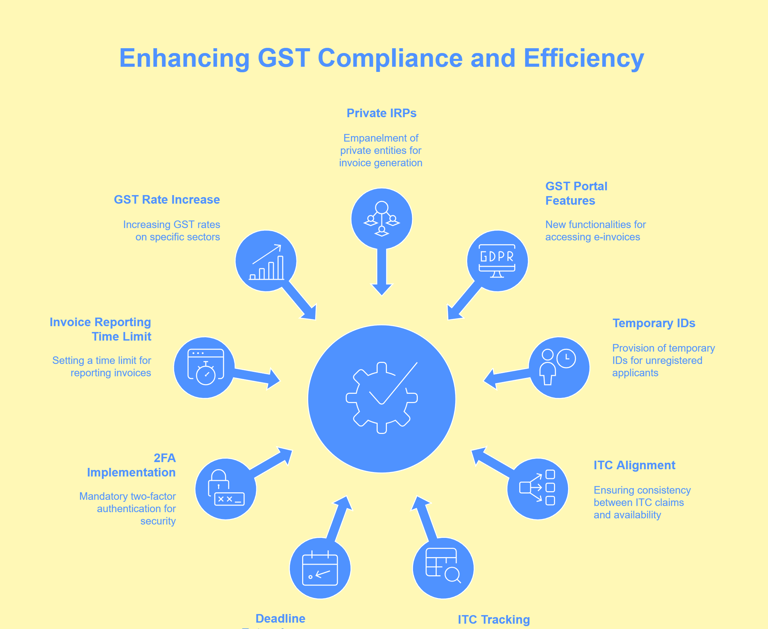9 Latest GST and E-invoicing Updates Simplified
There have been quite a few GST rule changes, new functionalities and features released on GST system recently. Significant developments are poised to influence the way businesses and taxpayers interact with the GST framework, presenting opportunities for smoother compliance and fostering greater transparency. In this article, we will unpack the intricacies of these recent GST updates. We aim to provide you with a comprehensive overview of the evolving GST scenario, equipping you with the knowledge necessary to navigate the changes with confidence. From revised compliance procedures to nuanced policy adjustments, our goal is to empower you with the insights required to make informed decisions in the ever-evolving GST environment.
Vaishali Patel
6/18/20253 min read


1. Availability of E-invoice JSON on GST Portal
With empanelment of private IRPs, IRIS being on IRP, suppliers have choice to use one or many IRPs for IRN generation. GST system is central repository where all IRPs push the e-invoices generated by them.
There are new features released on GST portal that can be used by taxpayers to get the e-invoices generated by them and e-invoices generated for them as purchaser from all IRPs.
2. Temporary ID for unregistered applicants
While the exemption to get compulsory registration for businesses supplying through e-commerce operators was announced last June in 47th GST Council Meeting, APIs for GSPs are released now. These APIs will help you to search or verify a Temporary Enrollment ID, like GSTIN search. We are in the process of updating these functionalities in our platform and in Peridot app and will keep you posted once released.
3. Alignment between Input Tax Credit claims in GSTR-3B and available ITC in GSTR-2B
The GSTN has introduced Compliance Pertaining to DRC-01C, addressing discrepancies between Input Tax Credit (ITC) in GSTR-2B and ITC claimed in GSTR-3B. Rule 88D, inserted through Government Notification No. 38/2023 – Central Tax on August 04, 2023, now operates on the GST portal.
It compares ITC from GSTR-2B/2BQ with that from GSTR-3B/3BQ for each return period. If claimed ITC exceeds ITC available per GSTR-2B by defined limits, taxpayers receive intimation in Form DRC-01C. In response, taxpayers can use Form DRC-01C Part B to provide payment details via Form DRC-03, explain the difference, or combine both options. Failure to respond will impact filing subsequent period GSTR-1/IFF.
4. Statement of ITC Reversed and Reclaimed
Starting August 2023, you’ll be able to track ITC that’s reversed in Table 4B(2) and reclaimed in Table 4D(1) and 4A(5) for each return period. Taxpayers can declare their opening balance for ITC reversal until November 30, 2023, with a maximum of 3 amendments allowed until December 31, 2023.
In the IRIS platform, you can classify invoices based on your ITC position, including reversal and reclamation. Our recent premium feature, Recon planner, helps you define rules for automatic invoice classification, simplifying ITC tracking. Tagging ITC in IRIS GST makes it easy to compare with government statements. Read details: Electronic Credit Reversal and Reclaimed Statement.
5. Extension of deadline for claiming ITC and issuing credit notes
The deadline for claiming ITC and issuing credit notes has been extended to 30th November from FY 2021-22.
6. Mandatory 2-factor authentication (2FA) for taxpayers with an AATO of Rs. 20 crore or more
All taxpayers with an Aggregate Annual Turnover (AATO) of Rs. 20 crore or more will be required to implement 2FA for their e-invoicing processes from 1st November 2023. 2FA is an additional security measure that requires users to enter two different factors, such as a password and a one-time password (OTP), to authenticate their identity.
7. New time limit for reporting invoices on the IRP portal
Taxpayers with an AATO of Rs. 100 crore or more will now be required to report invoices on the IRP portal within 30 days from the date of the invoice. This new time limit is effective from 1st November 2023.
8. Increased GST rate on casinos, race courses, and online gaming
The GST rate on casinos, race courses, and online gaming has been increased from 18% to 28%. This change is effective from 1st November 2023.
9. 52nd GST Council Meeting: Key Highlights
The 52nd GST Council Meeting, led by Union Minister for Finance & Corporate Affairs, Smt. Nirmala Sitharaman, took place on October 7, 2023, in New Delhi. Read key highlights here.
In conclusion, staying abreast of the latest GST and E-invoicing updates is pivotal for businesses and taxpayers alike. These simplified insights into the top 9 updates serve as a valuable resource, enabling you to navigate the ever-evolving regulatory landscape with ease and confidence. With these updates at your disposal, you can ensure compliance, streamline processes, and adapt to the changing tax environment. The world of GST and E-invoicing continues to evolve, and being informed is the first step toward success in this dynamic arena.